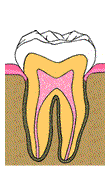|


What is a Root Canal?
Is
a Root Canal for You?
What
is Involved in a Root Canal Procedure?
Is
the Root Canal Procedure Painful?
Will I Feel Anything After Root Canal
Treatment?
What is dental pulp?
How will my tooth feel after root canal therapy?
Can a root canal tooth still get a cavity?
Why can't I just take antibiotics?
Will the abscess affect my other teeth
or my body?
What are the alternatives to root
canal treatment?
How does the type of restoration (filling)
affect treatment?
What other factors effect root canal treatment?
What
is a Root Canal?
A root
canal is the common term for treatment of an infected or inflamed
dental pulp, also known as an abcess. It consists of removal
of the affected tissue inside the tooth, cleansing and debridement,
followed by a root filling. Bone loss around the roots of
the teeth may be present depending on the extent of the problem,
but this generally repairs within 6-12 months in healthy patients.
Back
to Top
Is
a Root Canal for you?
Do
you have any of the following symptoms?
- Sensitivity
to hot or cold that lingers
- Discomfort
when chewing or biting
- Dull
ache
- Discomfort
that wakes you up at night
- Your
dentist has diagnosed the need for endodontic treatment
either by clinical exam or x-ray
If
you answered yes to any of the above, you might very well
need a root canal.
Please call and schedule for an evaluation.
Be
aware not all teeth that ARE in need of root canal therapy
will cause pain. It is possible to be pain-free and still
need a root canal.
Back
to Top
What
is Involved in a Root Canal Procedure?
The endodontist
examines the x-ray and the tooth, then administers a local
anesthetic. After the tooth is numbed, a small protective
sheet, called a dental-dam is placed to isolate the tooth,
a small opening will be made in the crown of the tooth and
small instruments will be used to clean the canals and to
shape the canal spaces for filling. Once the canals have been
adequately cleaned and shaped, the canals will then be filled
with a rubber-like material called "gutta-percha"
and sealer. A temporary filling is then placed to close the
opening. Your dentist will remove the temporary filling before
the tooth is restored.
Back
to Top
Is
the Root Canal Procedure Painful?
With modern
techniques and anesthetics the procedure is much faster and
with less discomfort than there has ever been. Dr. Bryan is
expert at achieving anesthesia in inflamed cases. Even patients
who have a history of difficulty in getting numb experience
profound numbness. Some of the anesthetic agents last for
up to six hours, but for patient's who have been in pain for
a day or two this is a blessing. Some patients delay treatment
for fear of pain, thus allowing the inflamation to reach unbearable
limits. This is the pain associated with root canals. After
undergoing treatment, they often experience immediate relief
and express regret for having postponed treatment. Patients
undergoing routine root canal treatment may have mild soreness
when chewing but that usually goes away in a day or two.
Back
to Top
Will
I Feel Anything After Root Canal Treatment?
In most
cases the quantity and quality of discomfort will subside
dramatically within the first 24-48 hours. Any sensitivity
to cold, hot or even breathing air "in" will be
gone after your visit. Nevertheless, you may experience mild
discomfort that will last for several days after treatment.
Taking over-the-counter medications such as aspirin, Advil,
Motrin, or Aleve usually relieves this discomfort. Tylenol
has been proven not to be as effective as aspirin, etc., because
it does not have the anti-inflammatory component as these
other medications. The most common complaint is tenderness
to touch, bite, tapping or chewing on the tooth. It is recommended
to refrain from any of the above until your dentist permanently
restores your tooth.
Back
to Top
What
is dental pulp?
The dental
pulp is the blood and nerve supply contained in the pulp chamber
and roots of each individual tooth. Pulp is important in the
growth and development of the tooth. In adult teeth, it is
responsible for the mature internal tooth structure, called
dentin. Over our lifetime continued deposition of dentin strengthens
the tooth in response to chewing and function. It also provides
a limited repair mechanism for injury to the tooth.
Back
to Top
How
will my tooth feel after root canal therapy?
You will
have immediate relief from hot or cold hypersensitivity in
that tooth. Patients assume their tooth or the nerve will
be "dead". It is still very much attached to your
body and functions just as any other tooth.
Back
to Top
Can
a root canal tooth still get a cavity?
Yes, only
without the nerve, you would not feel it because the nerve
acts as an internal warning system. Root canal teeth are not
more susceptible to decay than your other teeth, and proper
brushing and flossing will help prevent decay. Your family
dentist checks your teeth for decay during your six-month
checkup. He/she also examines your teeth for broken or loose
restorations, cracks, any signs of gum disease (periodontitis),
problems with your bite, and performs a cancer screen.
Back
to Top
Why
can't I just take antibiotics?
Antibiotics
are carried through the body via the bloodstream. The pulpal
blood supply is very limited and diminishes quickly when inflammation
or infection occurs. Antibiotics cannot enter into the tooth
roots and the root canal system becomes a perfect bacterial
breeding ground protected from tooth paste, mouthrinses, and
your own immune system. Bacteria may enter the tooth by decay,
cracks, or old restorations. The microscopic pathways are
interstate freeways for bacteria. There are approximately
500 different species of bacteria that live in the mouth,
and in any single infected tooth there may 10-15 different
species. Antibiotics may provide short term relief by attacking
the infection outside the roots of the tooth.
Back
to Top
Will
the abscess affect my other teeth or my body?
Teeth
are individual members and do not share the same pulpal blood
or nerve supply. 99% of teeth requiring root canal treatment
have bacterial contamination with the source of the bacteria
being the mouth. Multiple abcessed teeth may occur, but each
tooth has been compromised separately. Systemic infection
from an abcess does not occur in people with a healthy immune
system, nor does the infection throw out "seeds"
of infection that localize in other parts of your body.
Back
to Top
What
are the alternatives to root canal treatment?
One alternative
is to do nothing. Few patients find this an acceptable alternative
as any discomfort they are experiencing will usually increase
as the level of inflammation increases. While not all abcessed
teeth elicit pain, bone destruction or cracks in the teeth
will continue to expand such that the teeth cannot be saved
even when root canal treatment is undertaken.
Extraction
is the other alternative. Removal of the tooth eliminates
the source of the problem, but introduces a new question.
How do we replace the missing tooth? Replacement of the tooth
may not only compromise teeth adjacent to the space, but is
often more costly. If the tooth is not replaced, shifting
of the remaining teeth may lead to exposed root surfaces,
junctions that are difficult to cleanse making decay more
likely, and periodontal problems.
Back
to Top
How
does the type of restoration (filling) affect treatment?
The type
of restoration present is based on prior decay or injury as
well as the function and position of the tooth in the mouth.
Since most dental abcesses are the result of bacterial contamination,
the first step to relieving the problem is to eradicate any
decay, which is simply bacterial infection of the tooth structure.
The more restorations present in a tooth, the more cumulative
damage to the pulp. Any tooth with a crown may be considered
to have a "battered pulp" as this is a large, strong
restoration usually placed when not enough tooth structure
remains to support a filling. Any tooth that has decay adjacent
to the margin of the restoration is providing a freeway for
bacterial penetration. These restorations must be replaced
to avoid a recurrent abcess. Older restorations are more likely
to have defective margins. Crowns and bridges complicate treatment
in two ways. Radiographically we cannot see through the metalwork,
thereby not being able to accurately diagnose decay underneath.
Secondly, working inside a tooth with a crown is similar to
being in a dark tunnel. Modern illumination and magnification
are essential for accuracy in a microsurgical environment.
Back
to Top
What
other factors affect root canal treatment?
The age
of the patient, and the position of the teeth also may affect
root canal treatment. Roots are still growing and developing
until 16-21 years of age. A young child may be treated so
as to preserve the pulp if possible, thus permitting mature
growth and strengthening of the internal tooth structure.
As we
age, the pulp chamber becomes smaller as a result of continued
deposition of dentin, the internal layer of tooth structure.
One analogy is the way trees add on rings of bark on the outside,
dental pulp continues to add layers of dentin to the inside
of the roots thus the canals become smaller as we age. This
process may be accelerated by trauma or injury to the pulp.
This is referred to as calcification of the internal pulp
chamber and canals. Ordinarily canals may be smaller than
the diameter of a hair, and when calcified they may be very
difficult to find or negotiate.
The position
of the teeth in the mouth affects treatment in several ways.
The back teeth are obviously harder to reach, unless you are
the patient with the fliptop head. Secondly, the number of
roots vary with the tooth. Front teeth generally have one
root and one canal but molar teeth have 2-3 roots with 3-4
canals. Rotated teeth, and teeth out of line also may pose
complicating factors.
Back
to Top
|
